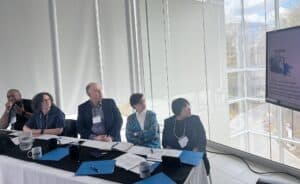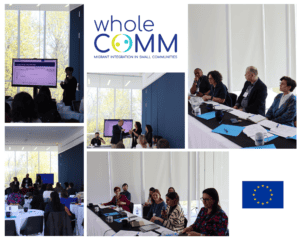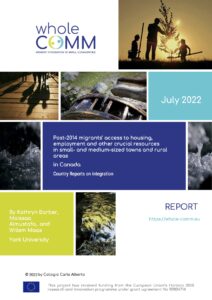
Explosive Growth in International Students in Canada
The complexities and challenges of Canada’s growing international student population and its implications for the country’s educational and financial systems.
Whole-COMM is funded by the European Union within the Horizon 2020 research and innovation programme and focuses on the integration of migrants in small and medium-sized towns and rural areas in 40 local communities in 8 EU countries (Austria, Belgium, Germany, Italy, the Netherlands, Poland, Spain and Sweden) and 2 extra-EU countries (Turkey and Canada).
By focusing on small and medium-sized towns and rural areas, Whole-COMM contributes to filling a serious gap in existing research and policy debates focused only on large cities.
Whole-COMM aims to make a concrete contribution to the formulation of innovative and effective policies. To do so, it intends to involve stakeholders at all levels—European, national and local—through two main modalities: community-policy LABs, designed as moments of discussion and connection between researchers and public decisionmakers; and the co-creation of a set of actions and policy directions by a trans-local working group.
Ontario is the most populous province in Canada (14.8 million, accounting for 38.7% of Canada’s total population), and it attracts the highest number of the immigrants. In 2019/2020, 44.7% of all immigrants to Canada settled in Ontario, a level similar to what was observed in 2018/2019. In 2021, this number reached 107,865 immigrants. During the period of 2015 – 2020, Ontario received the highest number of the total resettled refugees admitted to Canada (40%). In 2019, the number of protected persons and refugees admitted to Ontario (25,546) was more than 52.6% of the national total.
Québec is Canada’s second-most populous province (8.6 million, 22.5% of Canada’s population). In 2019, it was the fourth largest receiver of permanent migrants (11.9%). In 2021, this total reached 33,665 immigrants. Québec possesses a unique migration policy relative to other Canadian provinces. It accounts for the majority of francophone migration to Canada. Québec received the second highest number of resettled refugees admitted to Canada (18.3%) with more than 31,500 refugees during 2015 – 2020. In 2019, Québec received around 15% of the total protected persons including asylum seekers and resettled refugees admitted to Canada.
British Columbia is the third-most populous province in Canada (5.15 million, 11.4% of the national population) and second receiver of international immigrants with 15% of the national total. During 2021, the total number of immigrants to British Columbia was 34,385. British Columbia received the third highest number of resettled refugees in Canada during the period from 2015 and 2020 (8.4%) with a total of 14,580 refugees. In 2019, British Columbia received more than 7.6% of the total protected persons and resettled refugees admitted to Canada.
In recent years, the European Union has taken in an unprecedented number of migrants and asylum seekers who have arrived outside of planned flows. This has led to an increasing presence of migrants in small and medium-sized cities and rural areas (SMsTRA is the English acronym we use in the project), which are often poorly prepared for this novelty. Today, the challenges of integration loom even larger: on the one hand, Covid-19 is testing key economic sectors characterised by a high incidence of migrant workers and, on the other hand, small and medium-sized cities and rural areas are once again at the forefront of refugee reception, following the arrival of thousands of Ukrainians across EU member states.
How these communities respond to these challenges and to the settlement of migrants in their territory is critical to the future of migrant integration in Europe.
The project uses the innovative Whole-of-Community research approach, which echoes the notion of Whole-of-society promoted by the United Nations Compacts. This method conceives of integration between migrants and natives as a community-making process determined by the interactions of multiple actors (from political representatives to civil society and foreign residents) and whose outcome is not a foregone conclusion. This community-making process can in fact generate more cohesive and open societies, but also more closed and fragmented communities.
To study the mechanisms that influence the complex relationship between integration policies and local community cohesion, the project takes a comparative approach between countries (8 EU and 2 non-EU countries) and between local contexts (49 localities). The research is carried out using different methods, both qualitative and quantitative, including an extensive survey of attitudes towards refugees and asylum seekers in small municipalities and an analysis of the impact of local policies on social cohesion and immigrant integration trajectories.

The complexities and challenges of Canada’s growing international student population and its implications for the country’s educational and financial systems.

Two participants from small communities in the UE reflect on the common threads and takeaways.

Canada’s 2022 population surged by over 1M, almost all growth comes from immigration.
Blog by Willem Maas.

A collaborative approach shaping the understanding of migrant integration in rural areas.

Whole-COMM’s TransAtlantic CommunityPolicy-LAB is a two-day conference, to be held on April 26 and 27, 2023 in Toronto.

This report looks at migrants’ access to housing, employment, and other relevant resources in different small and medium-sized towns and rural areas in Canada between 2016 and 2021. Primarily based on interviews conducted in each of the for selected municipalities, the report provides an overview of:1) the concrete barriers that post-2014 migrants are facing in
Per leggere gli articoli per intero:
Webinar: “So many countries, so many developments”
May 18th, 2021
Whole-COMM, MATILDE and Welcoming Spaces, organized the webinar Paese che vai, sviluppo che trovi – in English So many Countries, so many developments. This event represented an opportunity to discuss among local and national stakeholders on the link between migration and development of non-urban areas in Italy. The event took place among Italian partners and was held in Italian language.

Whole-COMM has received funding from the European Union’s Horizon 2020 research and innovation programme under grant agreement No 101004714
The content reflects only the authors’ views, and the European Commission is not responsible for any use that may be made of the information it contains.